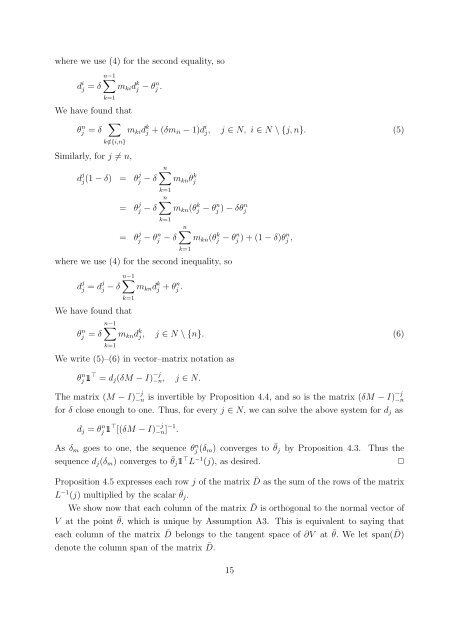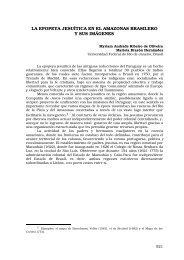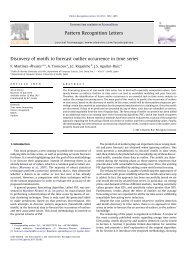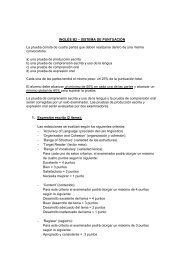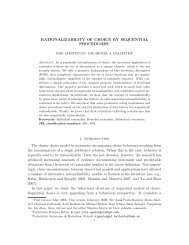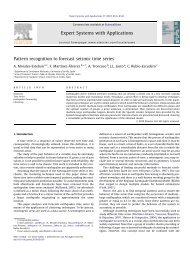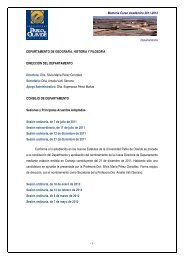We denote a column of ¯Θ by ¯θ. For i ∈ N \ {n}, we defined i (δ m ) = θi (δ m ) − θ n (δ m )1 − δ m.Let D(δ m ) be <strong>the</strong> n × (n − 1)–matrix with columns d 1 (δ m ), . . . , d n−1 (δ m ).The rest of <strong>the</strong> proof is organized as follows. In Proposition 4.5 we compute <strong>the</strong> limits ofd i (δ m ) as m goes to infinity. Proposition 4.6 establishes that <strong>the</strong> limit of {d i (δ m )} belongsto <strong>the</strong> tangent space to ∂V at ¯θ. We <strong>the</strong>n proceed to show in Proposition 4.8 that <strong>the</strong>limits of d 1 (δ m ), . . . , d n−1 (δ m ) are linearly independent and thus span <strong>the</strong> tangent space to∂V at ¯θ. And finally, Proposition 4.9 establishes that <strong>the</strong> gradient of <strong>the</strong> <strong>Nash</strong> productwith weights µ at <strong>the</strong> point ¯θ is orthogonal to <strong>the</strong> tangent space of V, <strong>the</strong>reby showing that¯θ is <strong>the</strong> µ–ANBS.For a matrix A, we denote by A −i and A −i <strong>the</strong> matrix A without its i th row and column,respectively. We write 1 <strong>for</strong> a column vector of ones and I <strong>for</strong> <strong>the</strong> identity matrix.For j ∈ N, we define <strong>the</strong> matrix L(j) byL(j) = [M − I] −j−n.Thus L(j) is <strong>the</strong> (n − 1) × (n − 1)–matrix obtained from M − I by deleting column j androw n. Proposition 4.4 is an auxiliary result used in <strong>the</strong> proof of Proposition 4.5.Proposition 4.4 The matrix L(j) is invertible <strong>for</strong> all j ∈ N.Proof: Suppose L(j) is singular. Let a be a non–zero vector such that [M − I] −j−na = 0.Since <strong>the</strong> elements in any column of <strong>the</strong> matrix M − I add up to zero, we also have <strong>the</strong>equation (M − I) −jn a = 0, so [M − I] −j a = 0. By using [M − I] −j = (M − I)I −j anddefining b = I −j a, we see that (M − I)b = 0. Thus <strong>the</strong> vector b is an eigenvector of Massociated with eigenvalue 1. By <strong>the</strong> Perron–Frobenius <strong>the</strong>orem, any non-zero eigenvectorof M associated with eigenvalue 1 is a strictly positive vector. However, since b j = 0, wehave obtained a contradiction. Consequently, <strong>the</strong> matrix L(j) is invertible.✷Proposition 4.5 The sequence {D(δ m )} of matrices converges to <strong>the</strong> matrix ¯D with rowsgiven by ¯d j = ¯θ j 1 ⊤ L −1 (j) <strong>for</strong> j ∈ N.Proof: We fix m and denote δ m by δ, θ i (δ m ) by θ i , and d i (θ m ) by d i .For each j ∈ N and i ∈ N \ {j, n},n∑d i j(1 − δ) = θ i − θ n = δ m ki θj k − θjn= δk=1n∑m ki (θj k − θj n ) + δθj n − θj n ,k=114
where we use (4) <strong>for</strong> <strong>the</strong> second equality, so∑n−1d i j = δ m ki d k j − θj n .k=1We have found thatθj n = δ ∑m ki d k j + (δm ii − 1)d i j, j ∈ N, i ∈ N \ {j, n}. (5)k /∈{i,n}Similarly, <strong>for</strong> j ≠ n,n∑d j j (1 − δ) = θj j − δ m kn θjkk=1n∑= θ j j − δ m kn (θj k − θj n ) − δθjnk=1= θ j j − θn j − δn∑m kn (θj k − θj n ) + (1 − δ)θj n ,k=1where we use (4) <strong>for</strong> <strong>the</strong> second inequality, son−1d j j = dj j − δ ∑m kn d k j + θj n .k=1We have found that∑n−1θj n = δ m kn d k j , j ∈ N \ {n}. (6)k=1We write (5)–(6) in vector–matrix notation asθ n j 1 ⊤ = d j (δM − I) −j−n, j ∈ N.The matrix (M − I) −j−n is invertible by Proposition 4.4, and so is <strong>the</strong> matrix (δM − I) −j−n<strong>for</strong> δ close enough to one. Thus, <strong>for</strong> every j ∈ N, we can solve <strong>the</strong> above system <strong>for</strong> d j asd j = θ n j 1 ⊤ [(δM − I) −j−n] −1 .As δ m goes to one, <strong>the</strong> sequence θ n j (δ m ) converges to ¯θ j by Proposition 4.3. Thus <strong>the</strong>sequence d j (δ m ) converges to ¯θ j 1 ⊤ L −1 (j), as desired.Proposition 4.5 expresses each row j of <strong>the</strong> matrix ¯D as <strong>the</strong> sum of <strong>the</strong> rows of <strong>the</strong> matrixL −1 (j) multiplied by <strong>the</strong> scalar ¯θ j .We show now that each column of <strong>the</strong> matrix ¯D is orthogonal to <strong>the</strong> normal vector ofV at <strong>the</strong> point ¯θ, which is unique by Assumption A3. This is equivalent to saying thateach column of <strong>the</strong> matrix ¯D belongs to <strong>the</strong> tangent space of ∂V at ¯θ. We let span( ¯D)denote <strong>the</strong> column span of <strong>the</strong> matrix ¯D.15✷


